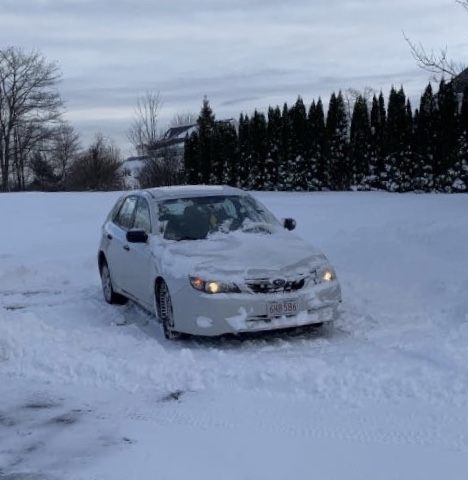Weathering Winter Roads

Warming up the car before leaving the house. Photo by Caroline Albert
December 10, 2019
Growing up, the sight of falling snow filled me with excitement; not only did the frosty white flakes signify a day of chilly play, it also brought with it the possibility of no school. However, as a driver, the joyous weather now only signifies slipping, sliding, and waking up extra early to start my car outside. Although it’s not nearly as fun as having a snowball fight, taking extra steps and being cautious as a driver, no matter how many years you’ve possessed a license, is crucial to your safety, as well as those around you. Like many, I have had to learn this through trusting myself, and practice.
The only sure-fire way to ensure your safety during dangerous road conditions is to simply not drive at all until circumstances improve. However, we know this may not always be possible, as we have to commute to school and jobs. Your second-best option is to practice safe driving habits, which can be learned from experts and average drivers alike. These tips are what I have personally learned through my experiences maneuvering in the snow.
Last winter was my first time driving in the snow, and being a school choice student, it was mandatory for me to safely get myself to from Oakmont every day. I could listen to the advice of my parents and driving instructors from before, but ultimately, nothing would teach me how to be as far away from harm as actually experiencing the roads for myself. It is an enormous responsibility.
The first step I take to prepare for the roads is by starting my car about ten minutes before I have to leave, with the heat on blast to defrost all of my windows for a clearer view of what’s happening outside. It is also extremely important to keep an ice scraper on-hand in case any patches are thick, with a brush to dust off layers of snow that may have accumulated overnight. Cars should never be started inside an enclosed area, such as a shut garage, because the levels of carbon monoxide in the air will become dangerous.
When the time comes to finally depart, I personally plan out my route in my head, thinking of any potentially difficult spots in the road, and whether it would be worth it to venture a different way. On the roads, my main strategies for reducing risks are to increase my following distance, in addition to braking earlier and slower. If I am familiar with the path I’m taking, it will be easier to brake sooner at any known problem spots, but it is always imperative to also begin braking earlier for cars in front of you. This is probably the main factor that prevents slipping and collisions, as you are able to gain and remain in control of your vehicle when slowing to a stop. If you find yourself slamming on your brakes abruptly, you are more likely to be unable to stop, and may find yourself skidding.
Essentially, the speed limit is another factor in your safety. Although the speed limit may be 40 miles per hour on the road you’re traveling, if the conditions are bad, you do not have to go as fast. During bad road conditions, your safety is most important, which is why you should give yourself extra time and be aware of how your car is handling the roads so you do not feel like you have to rush. In many cases, you might not be able to see all of the potential hazards on the roadways, such as black ice; in this instance, slowing to a more careful speed is always the right decision for an area of which you have uncertainty. Additionally, if another driver behind you is in a hurry, you can always pull over and let them pass you because not all cars drive the same in the snow, and not all drivers are as comfortable. Make a decision based on the conditions you’re facing, and do everything you can to remain in control of your vehicle. From what I have learned, when conditions are bad, they’re bad for everyone; therefore, other drivers on the road are typically driving as slow and careful as me.
According to Carsurance, there are 156,164 car crashes annually on average as a direct result of icy and snowy roads. 1,836 of those accidents result in death. Many of these tragic situations aren’t caused by recklessness, but by tricky conditions and the wrong timing. In my experience, driving to school during the winter can be as scary as it is difficult, but knowing how to manipulate the wheel in a way that brings me to my destination safely allows me to stay calm.
You can listen to your parents and driving teachers, who tell you to steer away from the skid, not slam on your brakes, and drive slow, but you will only understand and trust yourself once you practice safety on icy roads for yourself. Remember to take your time, pay attention to everything around you, and especially to increase braking and following distance. No matter what, your overall safety and life are far more important than a tardy strike, at all times.


